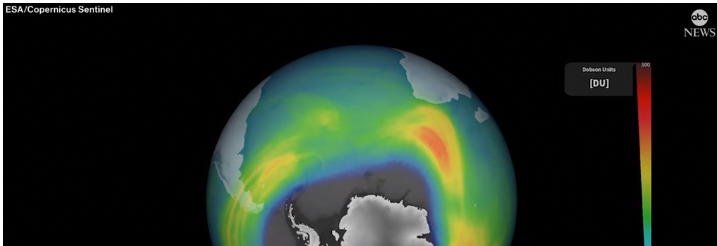|

October
4, 2023
By
Julia Jacobo
Ozone hole over Antarctica grows to
one of the largest on record, scientists say

ABC News Live Measurements from the
Copernicus Sentinel-5P satellite show this year’s ozone hole over the
Antarctic.
The annual ozone hole that forms over Antarctica
has ballooned to near-record size, scientists say.
Measurements from satellite imaging taken on Sept. 16 showed that the
ozone depletion area had reached 26 million square kilometers --
roughly three times the size of Brazil, according to Copernicus, the
European Union's Earth observation program.
Every year, an ozone hole forms over the Antarctic due to the presence
of ozone-depleting substances in the stratosphere and the specific
conditions of the region, according to Copernicus.
MORE: Ozone layer on track to
recover within decades: 'We need to be vigilant'
The annual ozone hole that forms over Antarctica
has ballooned to near-record size, scientists say.
Measurements from satellite imaging taken on Sept. 16 showed that the
ozone depletion area had reached 26 million square kilometers --
roughly three times the size of Brazil, according to Copernicus, the
European Union's Earth observation program.
Every year, an ozone hole forms over the Antarctic due to the presence
of ozone-depleting substances in the stratosphere and the specific
conditions of the region, according to Copernicus.

An iceberg floats near Two Hummock Island,
Antarctica, February 2, 2020. Ueslei Marcelino/Reuters, FILE
Ozone levels usually return to normal by
mid-December, after temperatures high up in the stratosphere rise in
the southern hemisphere, slowing the ozone depletion and weakening the
polar vortex, according to Copernicus.
A report released by the United
Nations Environment Programme in January found that the ozone
layer was on
track to recover within decades.
There is some speculation that the unusual
behavior of the ozone layer in 2023 is a result of the Tongan
underwater volcano eruption in January 2022.
The immense amount of water vapor that was
injected into the atmosphere likely just started reaching the south
polar region after the end of the 2022 ozone hole, Antje said.
The water vapor could have led to a heightened
formation of polar stratospheric clouds, allowing chlorofluorocarbons
to react and accelerate ozone depletion.
The impact of the widespread use of damaging
chlorofluorocarbons in products such as refrigerators and aerosol tins
in the 1970s and 1980s led to the depletion of the ozone high in the
atmosphere, allowing for the ozone layer above Antarctica to open up,
according to Copernicus.

Measurements from the Copernicus
Sentinel-5P satellite show this year’s ozone hole over the Antarctic.
Copernicus Sentinel/ESA
The Montreal
Protocol, a universally ratified United Nations treaty that went
into effect in 1989, phased out the production of ozone-depleting
substances, including CFCs.
Last month, the U.S. Environmental Protection
Agency delayed
plans to tighten ozone pollution standards until after the 2024
presidential election.
ABC News' Meredith Deliso and Gina Sunseri contributed to this report.
Green Play Ammonia™, Yielder® NFuel Energy.
Spokane, Washington. 99212
509 995 1879
Cell, Pacific Time Zone.
General office:
509-254
6854
4501 East Trent
Ave.
Spokane, WA 99212
|